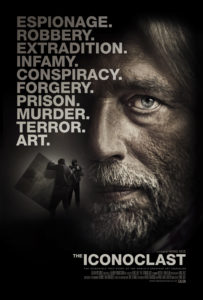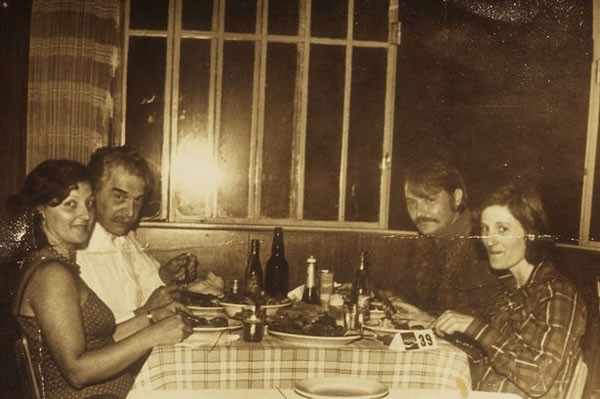Victoria Alexander reviews OPERATION FINALE and THE ICONOCLAST
Written by: Victoria Alexander | September 11th, 2018

Not how Eichmann was captured but how did he stay free and living easy for 15 years on the worldwide lam?
If only we were told how the principle architect of Adolf Hitler’s “Final Solution”, that savagely murdered millions of people across Europe, had escaped Nazi Germany to live a blissful life in Argentina for 15 years before a tip came across the desk of a Mossad agent.
Eichmann is credited with being the man who implemented and organized Germany’s Jewish deportations to extermination camps where the victims were gassed.
After disseminating Germany’s Jews, Eichmann’s genocidal efficient operation spread across Europe.
After Germany’s defeat in 1945, Eichmann fled to Austria. He lived there until 1950, when he moved to Argentina using false papers. Information collected by the Mossad, Israel’s intelligence agency, confirmed his location in 1960. A team of Mossad and Shin Bet agents captured Eichmann and brought him to Israel to stand trial.
What took them so long to find the man who glibly said that he would “leap laughing into the grave because the feeling that he had five million people on his conscience would be for him a source of extraordinary satisfaction.”
Along with many other SS officers who fled in the closing months of the war, Eichmann and his family were living in relative safety in Austria when the war in Europe ended on 8 May 1945. These men had carefully planned their escape. Would it be a shock to learn they had used forged papers? Or they had made influential agreements to guarantee their escape?
Eichmann made his way to Argentina where he was issued a humanitarian passport through an International Committee of the Red Cross. In Argentina, Eichmann lived a peaceful life with his wife, son Klaus and young son. He eventually found a job at Mercedes-Benz, where he rose to department head.
Eichmann was extensively interviewed for four months beginning in late 1956 by Nazi expatriate journalist Willem Sassen with the intention of producing a biography. Eichmann produced tapes, transcripts, and handwritten notes. The memoirs were later used as the basis for a series of articles that appeared in Life and Der Stern magazines in late 1960.
It does not appear to me that Eichmann was doing much to protect his identity. In fact, there was an entire cabal of escaped Germans and Argentines who lavished attention and praise on him.
Eichmann and his family lived in a remote village where he took the bus to and from work every day. He was prompt and followed a strict routine. There were no bodyguards. No security. No friends to call. No visible protection. Anyone could walk up to his house and knock on the door. People rode the bus with him every day for years.
How did Eichmann and Josef Mengele, with their crimes well known to the world, achieve this?
As told in OPERATION FINALE, a tip – just the word “Eichmann” – was sent to Mossad headquarters and agent Peter Malkin (Oscar Isaac) begged his boss, Rafi Eitan (Nick Kroll), to allow a team to go to Argentina and capture the man responsible for the holocaust. It wasn’t an easy request.
The “tip” had come from a girl, Sylvia (Haley Lu Richardson, the daughter of a half-Jewish German who began dating a young man who proudly used his real name, Klaus Eichmann (Joe Alwyn). He was proud of his father’s role in the war. Klaus was not hiding.
It certainly wasn’t very hard to capture Eichmann. The Mossad agents, not a squad of elite soldiers, but just a few men and one woman, Hanna Elian (Melanie Laurent) were the team. Hanna was brought along to sedate Eichmann after the capture and his departure for Israel. And to be Malkin’s love interest. Was this really necessary?
The only problem the team faced was slipping into Argentina and kidnapping Eichmann, which would violate Argentina’s laws. Obviously, Argentina benefited a great deal from harboring former Nazis and making them feel welcomed and safe.
Eichmann’s relatively open life is the prevailing mystery. As historical fact and OPERATIONAL FINALE dramatizes, it was as simple as a walk to the bus stop and Eichmann was caught. How he survived so well for so many years is the mystery that was never explained.
Who decided Eichmann’s time was up? Did his interviews make someone uncomfortable? What secrets were feared to be revealed if Eichmann kept talking?
Eichmann is placed in a safe house and thus begins the cat and mouse game between him and his captors. It only took Malkin and two other men to subdue Eichmann. The problem they faced was getting Eichmann to agree to sign a paper saying he was willing to go to Israel and stand trial.
With deprivation and threats not working on Eichmann, Malkin decides to begin a dialogue with Eichmann. He gives him a cigarette. He shaves the vainglorious man. Even though his sister was killed by Nazi forces, Malkin decides to seduce Eichmann by flattering his devotion to duty. He implores Eichmann to tell his side of the events. Eichmann believes, in my opinion, that this will be a starring role in a worldwide trial. Finally, his words and philosophy will be recognized. His pride won out.
Matthew Orton wrote the screenplay and the film was directed by Chris Weitz. Instead of making a dark film – after all, it’s about the Holocaust’s mastermind – it is filmed like a TV movie. The acting is heavy-handed, except for Kingsley, who is playing a preening Nazi who was used to everyone being terrified of him. Some of that arrogance slips neatly into Kingsley characterization. He plays Eichmann as a man with an outsized belief in his dignity. And, he never allowed one moment of guilt.

Traveling back from a tour of Baltic countries, I watched THE ICONOCLAST on the plane. It is the story of Dutch art thief Michel van Rijn. As van Rijn’s life is extravagant and bizarre, that is not enough for the ego mad van Rijn. Yes, he is charismatic, charming, and a man of vast culture. He’s got terrific stories to tell. But he ends his film biography with a startling, outrageous tale that complements OPERATION FINALE. Van Rijn’s story is about that other notorious Nazi: Dr. Josef Menegele.
From Wikipedia: Josef Mengele was a SS officer and physician in Auschwitz concentration camp. He performed deadly human experiments and selected victims to be killed in the gas chambers. He fled Germany to Argentina in 1948, using false documents given to him by the Red Cross. (According to the Mossad’s file, the organization was aware that it was helping a Nazi criminal escape justice.) In Buenos Aires, he lived at first under an assumed name, but later reverted to his own name. He even had a nameplate on his door: Dr. Josef Mengele. He drowned after suffering a stroke while swimming off the Brazilian coast in 1979 and was buried under a false name. His remains were disinterred and positively identified by forensic examination in 1985.
The synopsis of THE ICONOCLAST reads: Michel van Rijn made millions smuggling stolen icons, artworks, and rare antiquities into Europe and the USA, evading Interpol and the CIA. Throughout the 1970s and ‘80s he lived a playboy Jet Set lifestyle, living large and wide, bolstered by the false claim that he was a descendant of Rembrandt. Michel, however, was eventually captured, then extradited and imprisoned.

Michel ended up working for Scotland Yard, turning on the smugglers and forgers he had previously conspired with, drinking himself almost to death, and losing his son. In hiding at a Mossad-protected Jewish hotel in Europe, estranged from his family and seven ex-wives, Michel is under investigation from the FBI for masterminding the Isabella Stewart Gardner heist, where two unarmed men stole $500m worth of Rembrandts and other Dutch paintings, that remain unrecovered, and the crime unsolved.
As fascinating as van Rijn is, he tells an unbelievable story. He is known to have worked for the Mossad. Here he reveals the true story of the death of Mengele. Working with the Mossad on details, van Rijn and two other people, a man and a woman, went to Brazil to Dr. Mengele’s home, walked inside and grabbed him. They had a bucket of water and while the other man held Mengele down, Rijn drowned him in the bucket.
Can you imagine the Mossad allowing someone who never killed anyone, to assassinate Mengele?
Van Rijn and his helpers disposed of the body in the ocean, hence the official story that Mengele drowned while swimming.

